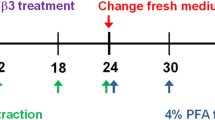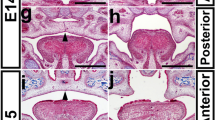Abstract
Mammalian palate development is regulated by complex processes. Many cellular and molecular events, such as cell proliferation, apoptosis, cell migration and the epithelial mesenchymal transition, regulate proper palate development and some abnormalities in palate development lead to cleft palate. Various developmental disorders, such as cleft palate and disorders of the lung, kidney and heart, are known to be associated with ciliary defects. Pitchfork, a mouse embryonic node gene, is associated with ciliary targeting complexes located at the basal body during primary cilia disassembly. To determine the function of Pitchfork during palate development, we examine Pitchfork expression patterns and morphological changes in the developing secondary palate after Pitchfork over-expression. From embryonic day 12.5 (E12.5) to E13.5 in mice, Pitchfork was highly expressed in the developing mouse secondary palate. Morphological differences were observed in vitro in cultured palates in the Pitchfork over-expression group compared with the control group. Pitchfork over-expression induced primary cilia disassembly during palate development. Sonic hedgehog and Patched1 expression levels and palatine rugae morphology were altered in the over-expressed Pitchfork group during palate development. Thus, the proper expression levels of Pitchfork might play a pivotal role in normal secondary palate morphogenesis.




Similar content being viewed by others
References
Berbari NF, O’Connor AK, Haycraft CJ, Yoder BK (2009) The primary cilium as a complex signaling center. Curr Biol 19:R526–535
Brugmann SA, Allen NC, James AW, Mekonnen Z, Madan E, Helms JA (2010) A primary cilia-dependent etiology for midline facial disorders. Hum Mol Genet 19:1577–1592
Bush JO, Jiang R (2012) Palatogenesis: morphogenetic and molecular mechanisms of secondary palate development. Development 139:231–243
Cho SW, Kwak S, Woolley TE, Lee MJ, Kim EJ, Baker RE, Kim HJ, Shin JS, Tickle C, Maini PK, Jung HS (2011) Interactions between Shh, Sostdc1 and Wnt signaling and a new feedback loop for spatial patterning of the teeth. Development 138:1807–1816
Cobourne MT, Green JB (2012) Hedgehog signalling in development of the secondary palate. Front Oral Biol 16:52–59
Dixon MJ, Marazita ML, Beaty TH, Murray JC (2011) Cleft lip and palate: understanding genetic and environmental influences. Nat Rev Genet 12:167–178
Dorn KV, Hughes CE, Rohatgi R (2012) A Smoothened-Evc2 complex transduces the Hedgehog signal at primary cilia. Dev Cell 23:823–835
Ferrante MI, Zullo A, Barra A, Bimonte S, Messaddeq N, Studer M, Dolle P, Franco B (2006) Oral-facial-digital type I protein is required for primary cilia formation and left-right axis specification. Nat Genet 38:112–117
Gritli-Linde A (2007) Molecular control of secondary palate development. Dev Biol 301:309–326
Hsiao YC, Tuz K, Ferland RJ (2012) Trafficking in and to the primary cilium. Cilia 1:4
Kemler R, Hierholzer A, Kanzler B, Kuppig S, Hansen K, Taketo MM, de Vries WN, Knowles BB, Solter D (2004) Stabilization of beta-catenin in the mouse zygote leads to premature epithelial-mesenchymal transition in the epiblast. Development 131:5817–5824
Kinzel D, Boldt K, Davis EE, Burtscher I, Trumbach D, Diplas B, Attie-Bitach T, Wurst W, Katsanis N, Ueffing M, Lickert H (2010) Pitchfork regulates primary cilia disassembly and left-right asymmetry. Dev Cell 19:66–77
Lee JM, Miyazawa S, Shin JO, Kwon HJ, Kang DW, Choi BJ, Lee JH, Kondo S, Cho SW, Jung HS (2011) Shh signaling is essential for rugae morphogenesis in mice. Histochem Cell Biol 136:663–675
Lee JM, Kim JY, Cho KW, Lee MJ, Cho SW, Kwak S, Cai J, Jung HS (2008) Wnt11/Fgfr1b cross-talk modulates the fate of cells in palate development. Dev Biol 314:341–350
Lipinski RJ, Song C, Sulik KK, Everson JL, Gipp JJ, Yan D, Bushman W, Rowland IJ (2010) Cleft lip and palate results from Hedgehog signaling antagonism in the mouse: phenotypic characterization and clinical implications. Birth Defects 88:232–240
Martin V, Carrillo G, Torroja C, Guerrero I (2001) The sterol-sensing domain of Patched protein seems to control Smoothened activity through Patched vesicular trafficking. Curr Biol 11:601–607
Martinez-Alvarez C, Blanco MJ, Perez R, Rabadan MA, Aparicio M, Resel E, Martinez T, Nieto MA (2004) Snail family members and cell survival in physiological and pathological cleft palates. Dev Biol 265:207–218
McMurray RJ, Wann AKT, Thompson CL, Connelly JT, Knight MM (2013) Surface topography regulates wnt signaling through control of primary cilia structure in mesenchymal stem cells. Sci Rep 3:3545
Nozawa YI, Lin C, Chuang PT (2013) Hedgehog signaling from the primary cilium to the nucleus: an emerging picture of ciliary localization, trafficking and transduction. Curr Opin Genet Dev 23:429–437
Oishi I, Kawakami Y, Raya A, Callol-Massot C, Izpisua Belmonte JC (2006) Regulation of primary cilia formation and left-right patterning in zebrafish by a noncanonical Wnt signaling mediator, duboraya. Nat Genet 38:1316–1322
Parada C, Li J, Iwata J, Suzuki A, Chai Y (2013) CTGF mediates Smad-dependent transforming growth factor beta signaling to regulate mesenchymal cell proliferation during palate development. Mol Cell Biol 33:3482–3493
Polkinghorn WR, Tarbell NJ (2007) Medulloblastoma: tumorigenesis, current clinical paradigm, and efforts to improve risk stratification. Nat Clin Pract Oncol 4:295–304
Rice R, Connor E, Rice DP (2006) Expression patterns of Hedgehog signalling pathway members during mouse palate development. Gene Expr Patterns 6:206–212
Rohatgi R, Milenkovic L, Scott MP (2007) Patched1 regulates Hedgehog signaling at the primary cilium. Science 317:372–376
Rot I, Kablar B (2013) Role of skeletal muscle in palate development. Histol Histopathol 28:1–13
Shin JO, Nakagawa E, Kim EJ, Cho KW, Lee JM, Cho SW, Jung HS (2012a) MiR-200b regulates cell migration via Zeb family during mouse palate development. Histochem Cell Biol 137:459–470
Shin JO, Lee JM, Cho KW, Kwak S, Kwon HJ, Lee MJ, Cho SW, Kim KS, Jung HS (2012b) MiR-200b is involved in Tgf-beta signaling to regulate mammalian palate development. Histochem Cell Biol 137:67–78
Sukarova-Angelovska E, Angelkova N, Palcevska-Kocevska S, Kocova M (2012) The many faces of oral-facial-digital syndrome. Balkan J Med Genet 15:37–44
Taya Y, O’Kane S, Ferguson MW (1999) Pathogenesis of cleft palate in TGF-beta3 knockout mice. Development 126(17):3869–3879
Toriello HV, Franco B (1993) Oral-facial-digital syndrome type I. In: Pagon RA, Adam MP, Ardinger HH, Bird TD, Dolan CR, Fong CT, Smith RJH, Stephens K (eds) GeneReviews [Internet] 1993-2014. University of Washington, Seattle. http://www.ncbi.nlm.nih.gov/books/NBK1188/
Tran PV, Haycraft CJ, Besschetnova TY, Turbe-Doan A, Stottmann RW, Herron BJ, Chesebro AL, Qiu H, Scherz PJ, Shah JV, Yoder BK, Beier DR (2008) THM1 negatively modulates mouse sonic hedgehog signal transduction and affects retrograde intraflagellar transport in cilia. Nat Genet 40:403–410
Zaghloul NA, Brugmann SA (2011) The emerging face of primary cilia. Genesis 49:231–246
Zhang Z, Song Y, Zhao X, Zhang X, Fermin C, Chen Y (2002) Rescue of cleft palate in Msx1-deficient mice by transgenic Bmp4 reveals a network of BMP and Shh signaling in the regulation of mammalian palatogenesis. Development 129:4135–4146
Author information
Authors and Affiliations
Corresponding authors
Additional information
Chengri Jin and Jong-Min Lee contributed equally as first authors. Hyoung-Seon Baik and Han-Sung Jung contributed equally as corresponding authors.
This study was supported by a grant from the Korean Health Technology R&D Project, Ministry of Health & Welfare, Republic of Korea (HI12C02970000).
Rights and permissions
About this article
Cite this article
Jin, C., Lee, JM., Tang, Q. et al. Morphological and molecular changes associated with Pitchfork during mouse palate development. Cell Tissue Res 358, 385–393 (2014). https://doi.org/10.1007/s00441-014-1950-5
Received:
Accepted:
Published:
Issue Date:
DOI: https://doi.org/10.1007/s00441-014-1950-5




